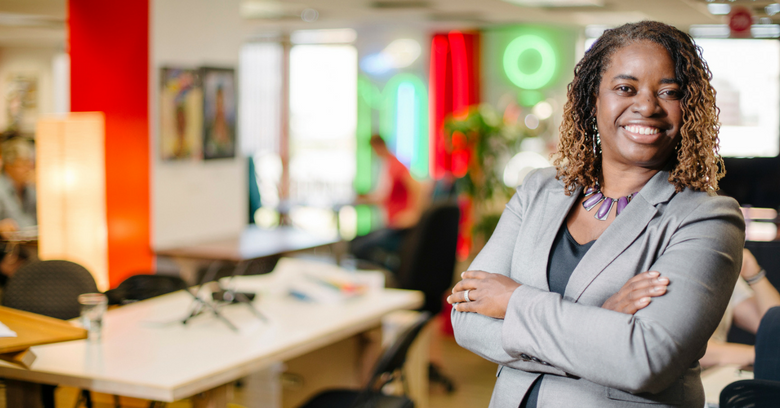By Roxie Hentz, as told to Violet Jinqi Wang
When I was in 5th grade, my parents transferred me to a school in the suburbs. The first time I walked into the classroom, I was stunned by the sea of white faces staring back at me. Tentatively walking to my desk and sitting down on the first day of school, the kids immediately moved away from me. As the only African-American person, actually the only person of color, period, I felt so foreign and isolated.
Luckily, my teacher that year was Stephan Staples.
I don’t know how he did it, but he taught us how to see value in difference, to see it not as a deficit, but as an asset. He practiced culturally-relevant teaching, addressing history and social issues not only from a dominant white lens but also from the perspective of people of color.
That’s the year I decided I wanted to become a teacher — I wanted to do what Stephan Staples did for my classmates and me. He ignited young minds and pushed us to think critically.
Students from low-income and minority backgrounds need the best teachers, but very often, the least experienced teachers are often placed in the most challenging schools. Throughout my 26-year career in education, I have purposefully chosen schools that either had a majority student population of low-income African American scholars or had a substantial racial achievement gap. I wanted to use my love and passion for teaching to impact those often most marginalized.
While a classroom teacher, I visited every single home of every kid I have ever taught. I have been invited and attended their sporting events, after-school activities, and important family events. I am seriously committed to my students’ education.
A teacher is not just someone who shows up, but someone who inspires and ignites learning. Year after year, my students outperformed city and suburban kids. New teachers and seasoned teachers often visited and observed my students and me in my classroom. We were regularly on television, in the newspaper, or on the radio for their exceptional academic performance. I started to train other teachers so I could generate a more significant impact on more students.
I thought, “Wow, I am pretty darn good at this. I actually get paid to do what I love — what I would really volunteer to do.”
Teaching gives me a natural high. Being able to teach and work with students is the best thing that has ever happened to me.
In 2011, I won a Fulbright Distinguished Teacher Award. I got this amazing opportunity to teach in Durban, South Africa at the University of KwaZulu-Natal for six months. During that time, I built a curriculum centered around teaching financial literacy through social entrepreneurship. In the university, I co-taught the Economics and Management Sciences course, where I was able to test parts of that curriculum. It’s that curriculum that I later translated into the nonprofit organization I am running right now, CEOs of Tomorrow.
What I found as a common trend for millennials and younger kids is that they don’t just want to make money to exist or survive. They want to do something meaningful. Social entrepreneurship, which aims to develop, fund, or implement solutions to social, cultural or environmental problems, seems to resonate with these students.
CEOs of Tomorrow offers kids from 4th grade to 12th grade the opportunity to learn how to transform ideas into businesses designed for social good. The organization offers youth workshops, camps and labs designed to empower youth to launch real businesses that address social issues and generate revenues. Participating high schoolers even have the opportunity to intern with entrepreneurs during the summer and earn a stipend and college credits for their work. The series of programs aims to offer a culturally-relevant experience, that advances their interest in entrepreneurship.
In the two years since I founded CEOs of Tomorrow, it has grown from a pilot program of 16 students to 91 students served in five programs last year.
People often ask me what businesses the students will start. But I play no role in that. When given the platform and opportunity, kids will surprise us adults with their innovation and creativity. Their business ideas come from them every time. They have started businesses to address inequities in education, gender equality, childhood cancer, homelessness, and other issues important to them. So far, all of their businesses have been profitable, and most importantly, many of the students have had the opportunity to donate a portion of their profit to a related cause with remaining profit distributed among themselves. Earning, saving, and spending the money they earn teaches them invaluable money management skills that are often not taught in schools.
This idea that we have to handhold our kids, that they are not capable unless we make them capable, is just a myth. Kids can tell if you are authentic and if you really care and trust them. Once their intelligence is unwrapped, you will truly be surprised and see amazing results. They exceed my expectations time and time again.
The problem is that kids often don’t know entrepreneurship is a viable option. I was lucky enough to see entrepreneurship in action from birth. My mother was a seasoned entrepreneur. She ran two successful businesses — Daisy’s Fashion House and Daisy’s Charm and Finishing School. She had a huge influence on me and my siblings. Five of the seven of us own a business today. Growing up in this environment, I always had the chance to test out my ideas and try new things. An entrepreneurial mindset is a way of thinking that is critical to any field and background. Whether an idea turns out to be a success or failure, the process of problem-solving, critical thinking, and innovative development are invaluable skills.
As I teach students how to view their successes and failures as learning experiences, I am also constantly challenged to do the same for myself. I am always testing, validating, and pivoting new programs designed to enrich and deepen authentic entrepreneurial experiences for our youth.
From teaching to training other teachers, to finally designing my own curriculum, I have always believed in the magical power of education — the same power that deeply transformed the little girl in 5th grade.

